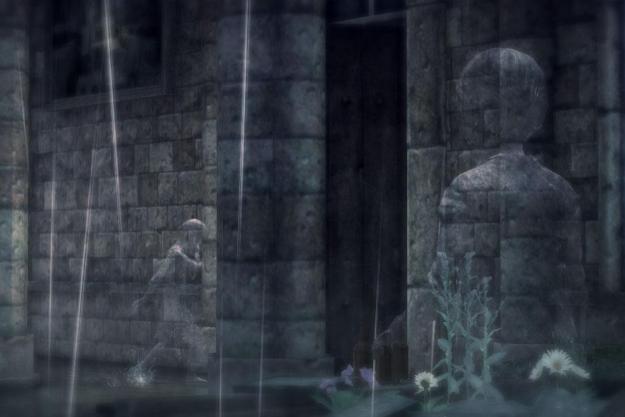
“If atmosphere alone could make a game, Rain would be a success. Unfortunately it is not.”
- Atmospheric world
- Original invisibility mechanism
- Exceedingly linear gameplay
- Puzzles that are barely puzzles
- The story never really builds on anything
Some games build their core around gameplay. Others pride themselves on the story. Some, as is the case with SCE Japan and PlayStation C.A.M.P.’s Rain, rely on something less common: the ability to convey an emotion.
Rain introduces melancholy and loneliness as its defining characteristic. From the opening chapter that begins with Debussy’s somber Clair de Lune, through the washed out colors and empty cobblestone streets, Rain relies heavily on a dour tone. Having a memorable atmosphere is one thing though, but games are by their very nature interactive and atmosphere without suitable gameplay means very little. This is where Rain falters.
Rain introduces melancholy and loneliness as its defining characteristic.
The story begins with a watercolor storyboard depicting a young boy who, while he’s stuck at home with a fever, sees the outline of an invisible girl from his window. He pursues her out into the night, and becomes similarly invisible. Like the girl, he finds himself chased by equally invisible creatures for reasons unknown.
The boy and the girl can’t speak (or make any sound) to each other while they are invisible, but they do come to share a bond despite their natural sense of isolation as they help each other survive. That isolation manifests through the defining mechanic of the game, the invisibility that is only broken by the rain. When the boy, the girl, and the creatures are standing in the continuous downpour, their silhouettes are revealed. The other side to that is that even something as simple as a balcony can offer a dry shelter, and in the dryness, invisibility and safety.
Rain is essentially a stealth-adventure game with some light puzzle-solving thrown in for good measure. You’ll have to hide and jump between cover to avoid creatures, but you always know where to go because the linearly laid out streets give you only one direction to move in, and one solution for getting out of there.
The puzzles are simple to the point of being monotonous. There is very little thrill to be found in working out a solution as easy as grabbing a cart and pushing it in the only direction it will move in, then jumping on it. Your range of interaction options are limited to running, jumping, and interacting with a very specific item or icon that is always highlighted for you to easily find. This may be an object that makes sound and distracts the game’s most fearsome enemy, the Unknown, or it may be a flashing door you need to go through.
The scarcity of any true puzzles also leads to repetition. Being chased by dog-like creatures that lose you when you step under cover can be thrilling, but it never evolves, so when you do this repeatedly it simply loses its appeal. That puts the bulk of the game on the story to keep you pushing forward.
Being chased by dog-like creatures that lose you when you step under cover can be thrilling, but it never evolves…
Without any dialogue or exposition – beyond the occasional text superimposed on the world that explains things like ‘the boy is looking for the girl’ – Rain’s motivations are weak. The boy willingly and happily chases after the girl because he can. Call it curiosity, call it the protective nature of humanity.
That’s a familiar trope in video games: the guy needs to save the girl (occasionally vice versa). But when it is that simple, it’s usually because the gameplay is the dominant feature and the story is secondary. That isn’t true in Rain. It’s also a short game, clocking in at just a few hours. It’s definitely possible to tell a meaningful story in a short period of time, but Rain never emphasizes – or even really characterizes – the boy or the girl. You are simply an avatar running towards a girl that is running from unseen enemies.
There are a few moments when the two characters meet up and have a moment to interact, but the game never sells the relationship. There is never a reason to care for them beyond the fact that they are children. The game is so heavily invested in the tone and the story over the gameplay that it needs more, much more, to make the connection between the boy and the girl carry any real weight, but it doesn’t. The characterizations end up being as transparent as their forms.

What you are left with is a melancholy world filled with downtempo piano music and a straight path to follow in which you hit a button every now and then. There are no collectibles to find, no exploration at all even, and no real gameplay challenges to solve. The atmosphere and the originality of the invisibility mechanic do make up for that a bit, but not nearly enough to raise Rain above the level of being mediocre.
Conclusion
SCE Japan and PlayStation C.A.M.P. try to do something different and unique in Rain, building a game that is centered on the concepts of loneliness and solitude. It’s a success on that level, but fails in offering a complete game.
This game was reviewed on a PlayStation 3 using a code provided by Sony.
Highs
- Atmospheric world
- Original invisibility mechanism
Lows
- Exceedingly linear gameplay
- Puzzles that are barely puzzles
- The story never really builds on anything
Editors' Recommendations
- All Baobab Tree locations in Tales of Kenzera
- 9 best processors for PC gaming: tested and reviewed
- 10 best gaming monitors of 2024: tested and reviewed
- Amazon’s Fallout series is crossing over with two Fallout games
- Fallout 4 is finally getting free Xbox Series X and PS5 upgrades






